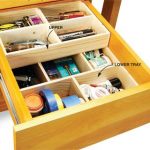We may receive a commission when you use our affiliate links. However, this does not impact our recommendations.
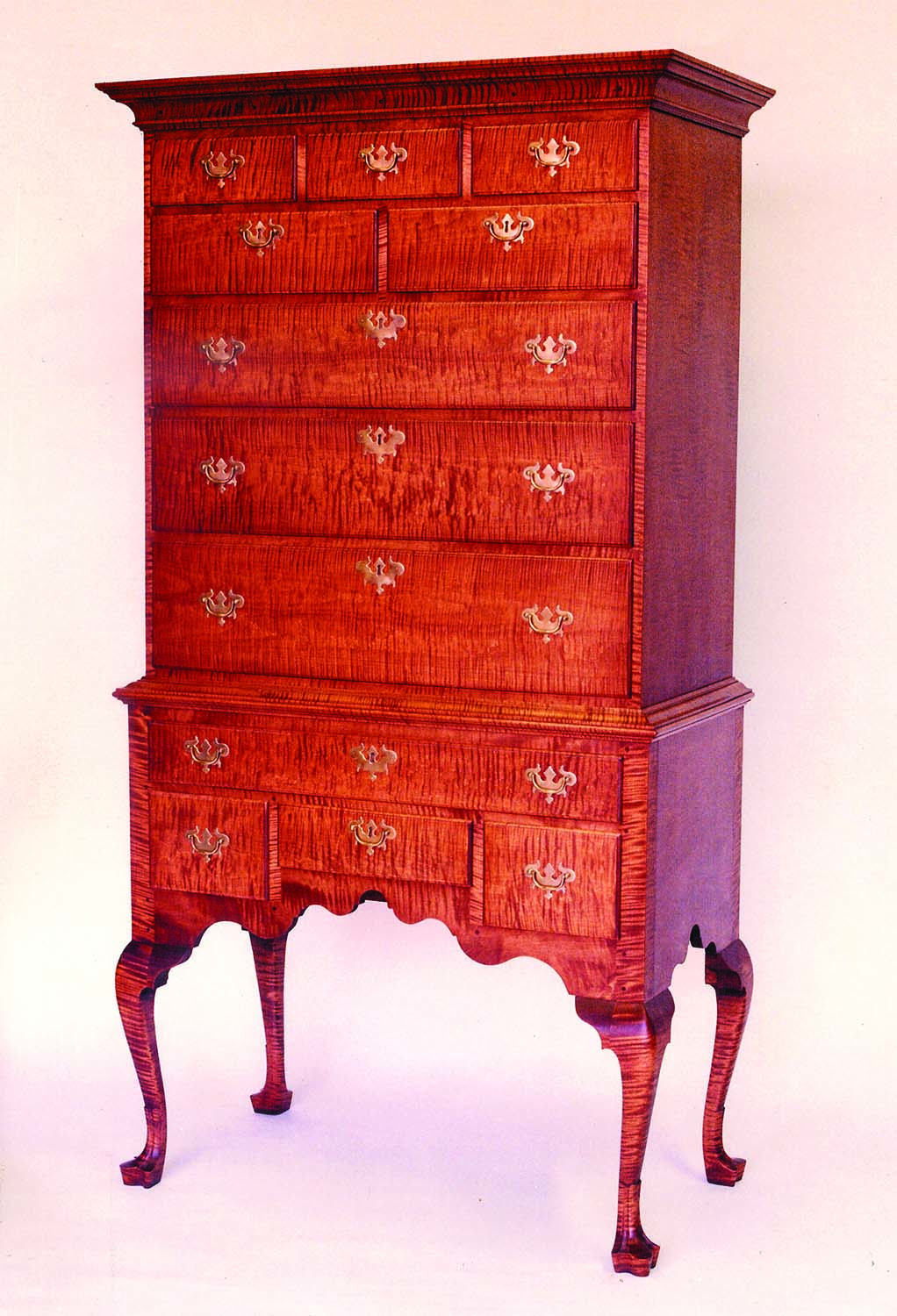
Flat top. Highboys remained popular in the Colonies long after they had gone out of fashion in England. In Chester County, the simpler flat-top highboy with its trifid feet remained popular long after ball-and-claw foot and bonnet-top highboys reigned in Philadelphia.
This Pennsylvania area developed unique and recognizable furniture.
From its green rolling hills in the south and plains-like farmland in its middle to the nearly mountainous terrain in the north, the topography of Chester County, Penn., is as diverse as its people and, more important, its furniture. As woodworkers, nearly everyone who is interested in period furniture has heard of Chester County. But do many even know where Chester County is?
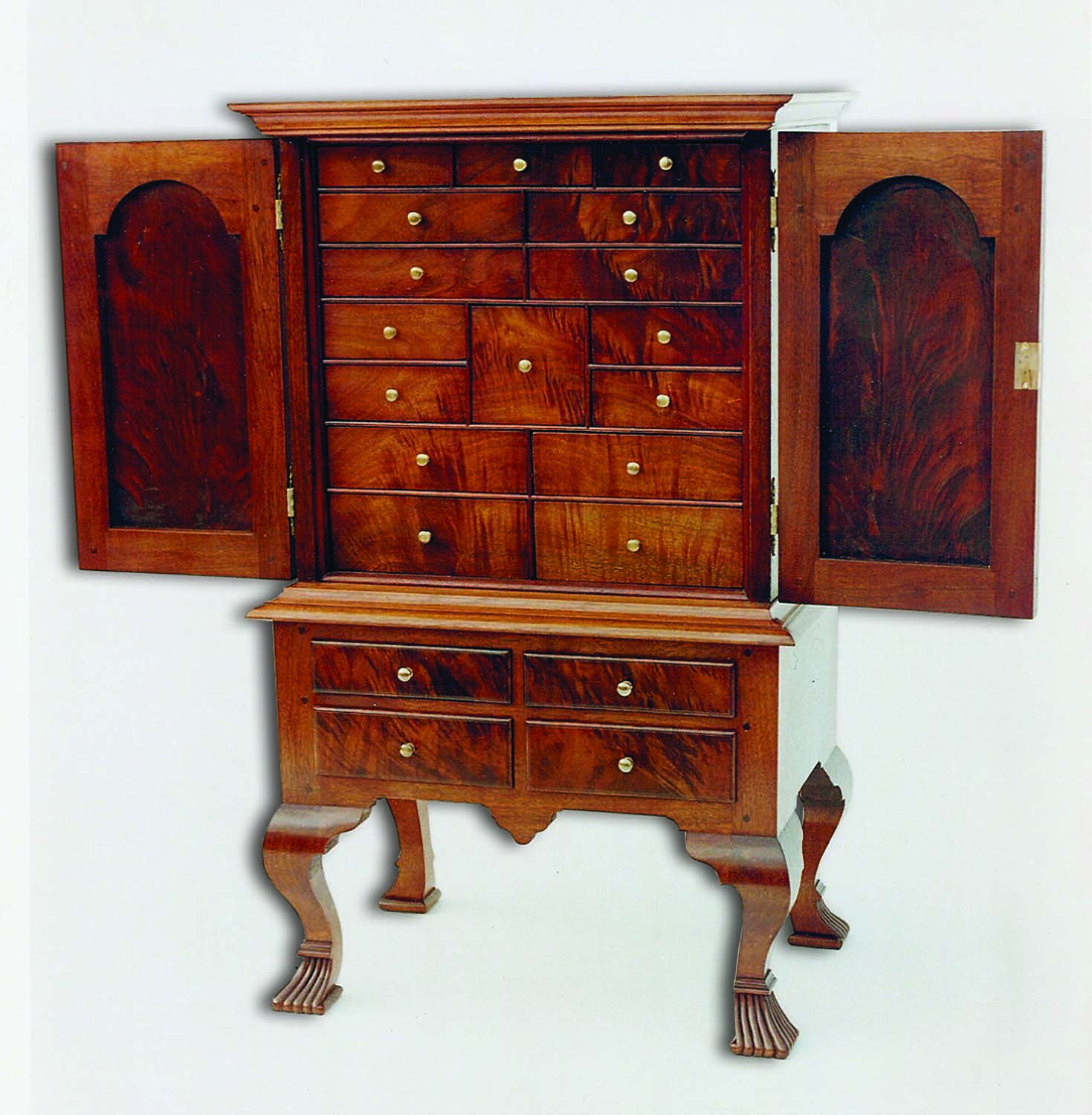
Spanish feet. While trifid feet and the more rococo ball- and-claw foot were the height of fashion in Philadelphia, the comparatively simple Spanish foot on this spice box on frame typify the Chester County style. And by the time trifid feet were out of style in the city, they were popular in Chester County.
By the middle of the 18th century, Philadelphia had become not only the largest city in the Colonies, but the center of furniture design and production. The most astounding thing is that just 25 miles or so west of the city, in the rural countryside of Chester County, a revolution was taking place. It wasn’t fought with musket and ball; it was a battle of taste. In order to understand what was taking place, we need to know the makeup of the residents of Chester County– one of William Penn’s three original counties.
When you study period furniture, there’s a lot of talk about regionalism. That is, different areas of the country had different preferences as to furniture proportion, ornamentation and overall design. What’s amazing about Chester County is that within one small county in Pennsylvania, we find significant construction and design differences.
Those micro-regional differences were driven by the diverse groups of people populating the different parts of the county. Once you understand the cultural makeup of the county, it’s easier to understand the furniture design variations. The one common thread, regardless of region within the county, was that the furniture had to be simple.
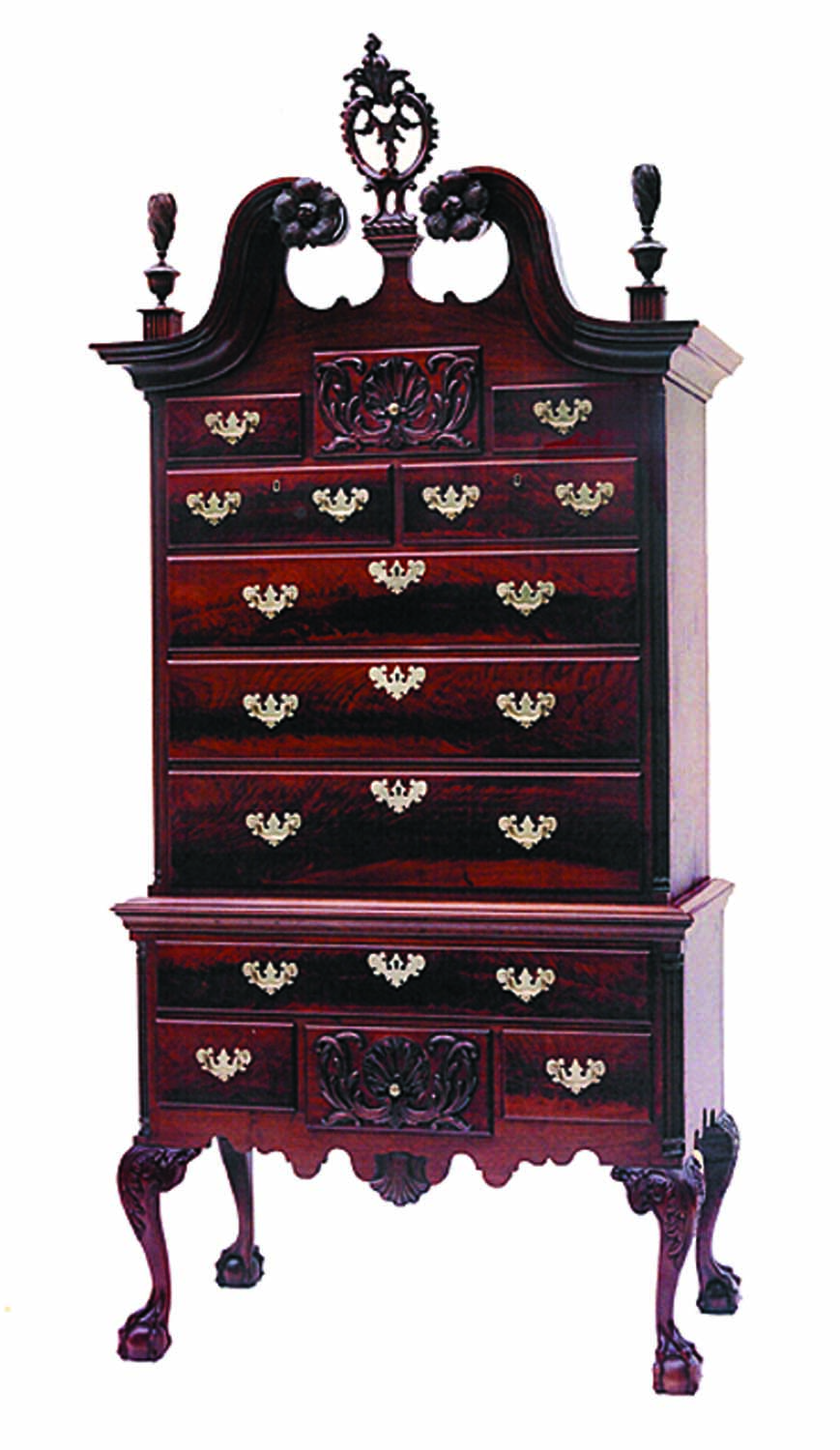
Philadelphia excess. This Philadelphia highboy, with ball-and-claw feet, is far more highly decorated than what came out of Chester County during the same period.
Throughout the 18th century, English and Welsh Quakers, Presbyterians and Church of England adherents settled in Chester County. Other European immigrants arrived as well but the majority were from England, Ireland, Scotland and Wales. The English Quakers settled in the eastern and southeastern parts of the county and in the Great Valley. Irish Quakers and Scots-Irish Presbyterians gravitated to the southern and western parts. The Pennsylvania Dutch settled in the north. These groups brought with them a wide variety of furniture design tastes and construction methods.
One reason for this migration to Chester County was the opportunity to make a living. Three major highways that connected to large cities in (Philadelphia, Lancaster and Reading) passed through the county, so there was a steady flow of goods and services. In the Colonies, wherever there was commerce, there were cabinetmakers and other craftsmen plying their trades.
Understated Design
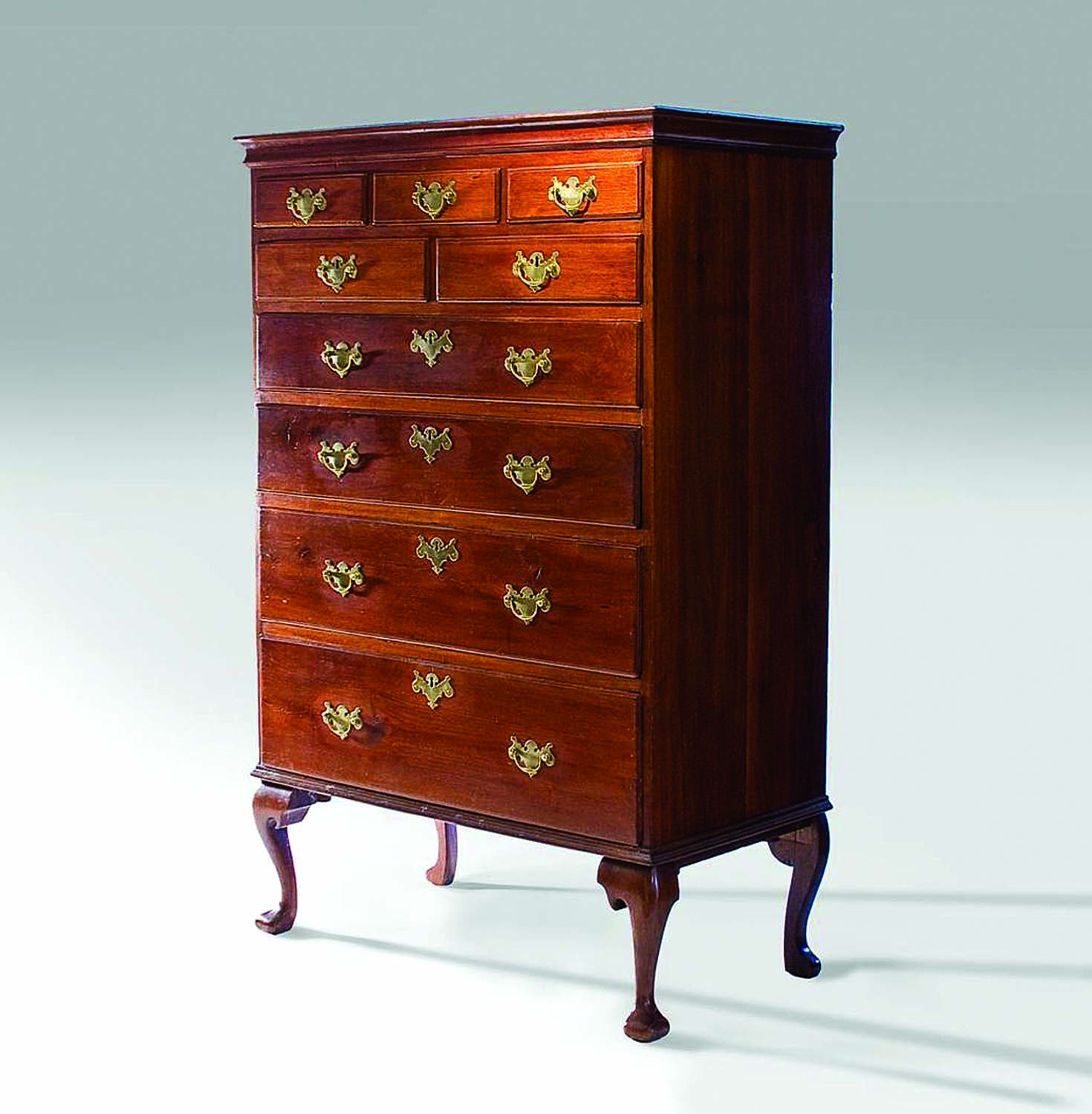
Bandy legs. While the squat bandy legs with block feet on this chest are examples of the plainer Chester County taste, the way in which they are attached to the carcase is specific to the Octorara creek area. The bandy legs are first attached to a cross member which is in turn attached to the case using wooden threaded screws.
 The English Quakers in Chester County brought simplicity to their furniture. While the likes of the Hollingsworth and Cadwalader families engaged elite Philadelphia cabinetmakers with commissions that rivaled their British cousins, Chester County families dealt with local craftsmen to create elegant pieces with far less ostentatious adornment. Trifid, pad and Spanish feet reigned when ball-and-claw and hairy paw feet were the rage in Philadelphia. The simple shell was preferred to the lush vegetation of rococo Philadelphia.
The English Quakers in Chester County brought simplicity to their furniture. While the likes of the Hollingsworth and Cadwalader families engaged elite Philadelphia cabinetmakers with commissions that rivaled their British cousins, Chester County families dealt with local craftsmen to create elegant pieces with far less ostentatious adornment. Trifid, pad and Spanish feet reigned when ball-and-claw and hairy paw feet were the rage in Philadelphia. The simple shell was preferred to the lush vegetation of rococo Philadelphia.
This is not to say that Chester County pieces were colloquial or unrefined. Chester County residents had regular dealings with their city counterparts, and they were educated and aware of the latest fashions in the city. The settlers tended to be more conservative and held on to forms and designs far longer than in many places.
Much like the Colonial affinity for the highboy (which had gone out of fashion in England long before the ripening of the Chippendale period, but remained popular in the Colonies until the Federal period) the residents of the county continued making spice boxes and other forms beyond the limits of fashion in the cities.
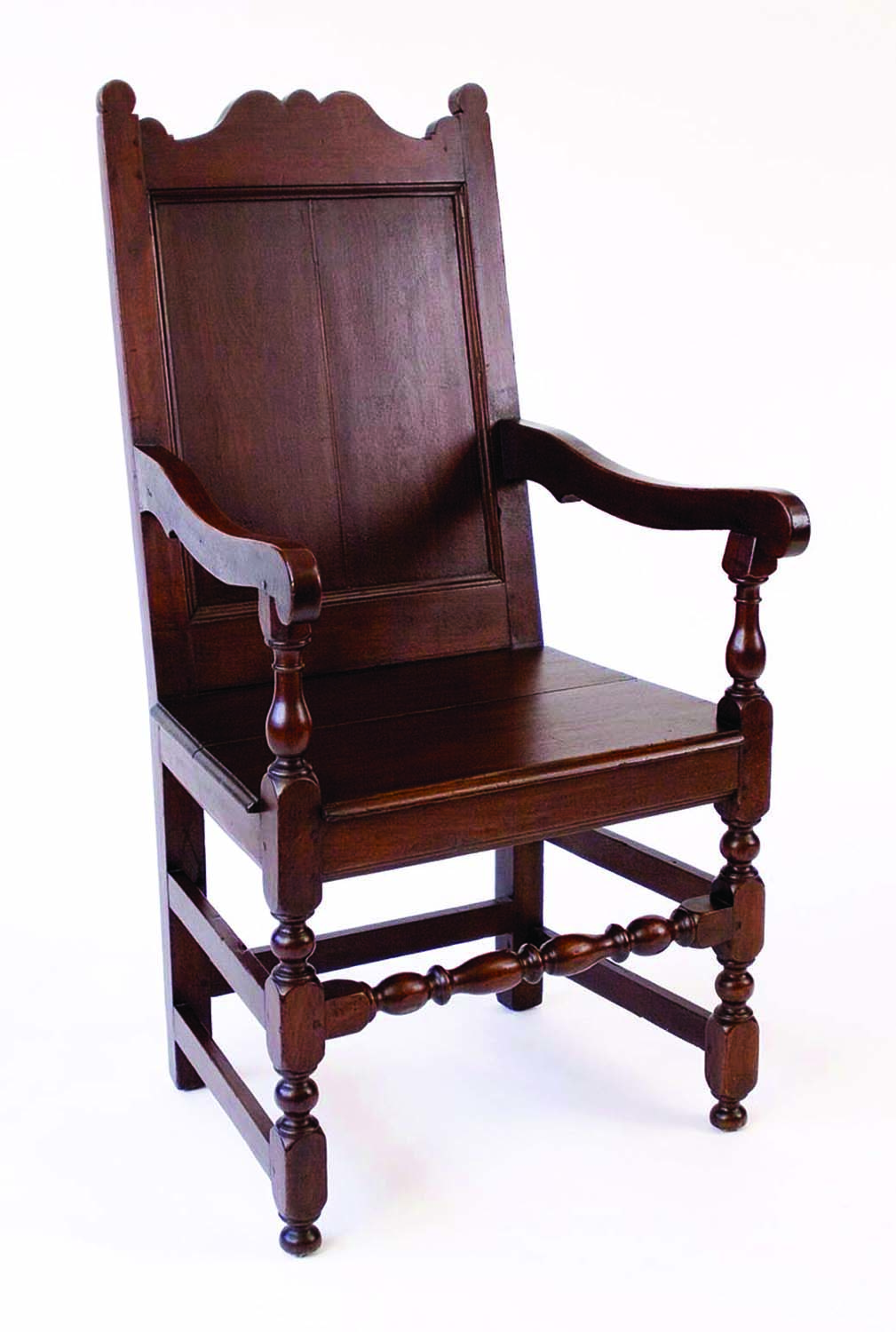
Wainscot chair. This furniture form was popular throughout the early years of the Colonies, in Chester County as well as elsewhere. Much like the spice box, the wainscot chair remained “in style” long after it had gone out of fashion in Philadelphia.
One of the primary regional differences between Chester County furniture and furniture from the city was wood selection. Mahogany was arriving with regularity into the port of Philadelphia throughout the 18th century. For city-dwellers, it was the fashionable wood of choice. Mahogany from Santo Domingo, Honduras and Cuba was the dominant species for Philadelphia’s wealthy because of its deep reddish-brown color and because of its workability. It carved well and finished even better.
For the plainer Chester County elite, mahogany never became more popular than the local walnut (though it was used in small amounts). Being more conservative led the county consumer to look for a wood that was similar in appearance and workability but readily available without heading to the docks of Philadelphia. Although walnut was predominant, other species, including mahogany, cherry and curly maple, were used as primary furniture woods.
Secondary woods in Chester County and the surrounding areas were local and included poplar, which was predominant, pine and chestnut. What is lacking is the regular use of yellow pine and white cedar that appear in pieces made in Philadelphia.
Joinery Methods
Looking at the joinery methods used in Chester County, we find similar methods employed as those used in Philadelphia. The mortise-and-tenon joint was used in joined pieces while the dovetail was the method of choice for case pieces. (Joined pieces essentially consist of four corner posts with rails mortised and tenoned into them. Case pieces are usually based on a box that is dovetailed together with a front and back or top and bottom.) The through-mortise-and-tenon joint was used on the rear legs of chairs in the county as it was in the city. Basic joinery is one area where little variation occurs. Still, there are some variations that occur that are unique to Chester County.
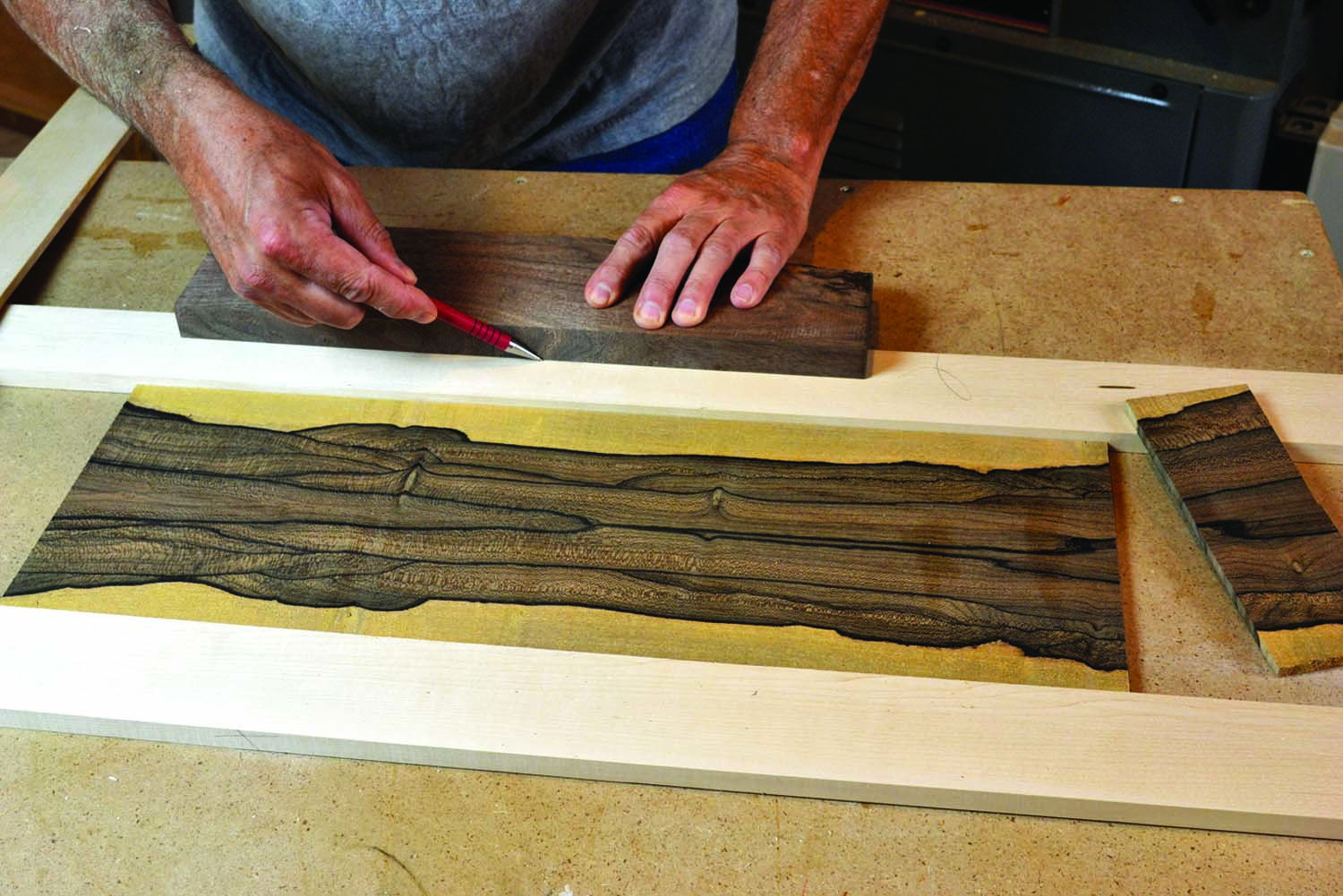
Line-and-berry inlay. This spice box exhibits line-and-berry inlay, which is found more often on Chester County pieces than on pieces from any other area.
These can best be illustrated in a discussion of the regional variations within Chester County. In other areas of the Colonies, regional tastes covered broader regions of land. The Connecticut River Valley covers a far greater area than Chester County, yet we find similar methods of construction and ornamentation along the entire valley.
Line-and-berry inlay, for example, shows up in the southeastern areas of Chester County, but not in the western or northern areas. There are other examples of design and decorative elements that are specific to certain regions of the county as well.
Farther south we find design elements that not only don’t occur in any other part of the county, but nowhere else in the region. Through this area of the county winds the Octorara Creek, alongside which craftsmen developed a unique flair within the popular styles Queen Anne and Chippendale styles of the day.
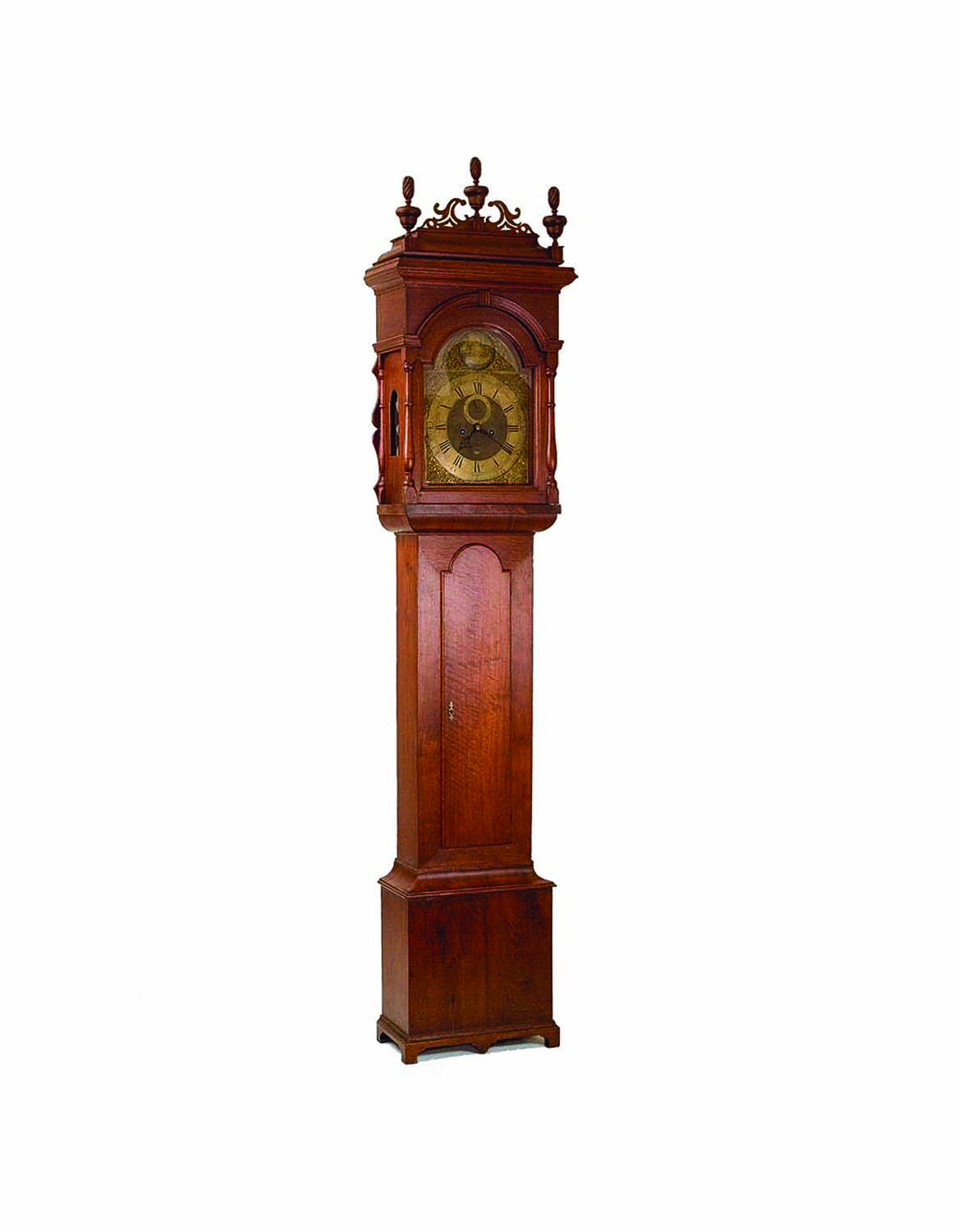
Tall clock. This Chester County tall clock would have been a status symbol for its owner. While the pieces of Chester County were plainer, they were by no means unsophisticated.
Like the chests created in Philadelphia, the craftsmen along the Octorara employed cabriole legs and ogee feet, but with a twist.
In New England, bandy leg chests had short cabriole legs with square stock at the top of the leg as an attachment point to the case. In the Octorara area, however, the bandy legs had no square stock on top of the legs. The front and rear legs of a chest were attached to one another, front to back, via a cross member. This board joined the two legs together and was then attached to the case using threaded wooden screws. This made moving the chest easier because the feet were removable.
Another Octorara distinction comes in the form of ogee feet, and there are a number of examples of low chests, tall chests and desks with ogee feet from the area. In many ogee feet, a small spur is part of the design that is created by a semi-circular cutout that radiates out from the main body of the foot. This semi-circular cutout then curves away from the main body of the foot in a convex arc leading to the part of the foot that terminates into the base moulding at the bottom of the case. On an Octorara foot, however, the cutout is a half-circle joining the point of the spur to the main body of the foot.
Inlay Abounds
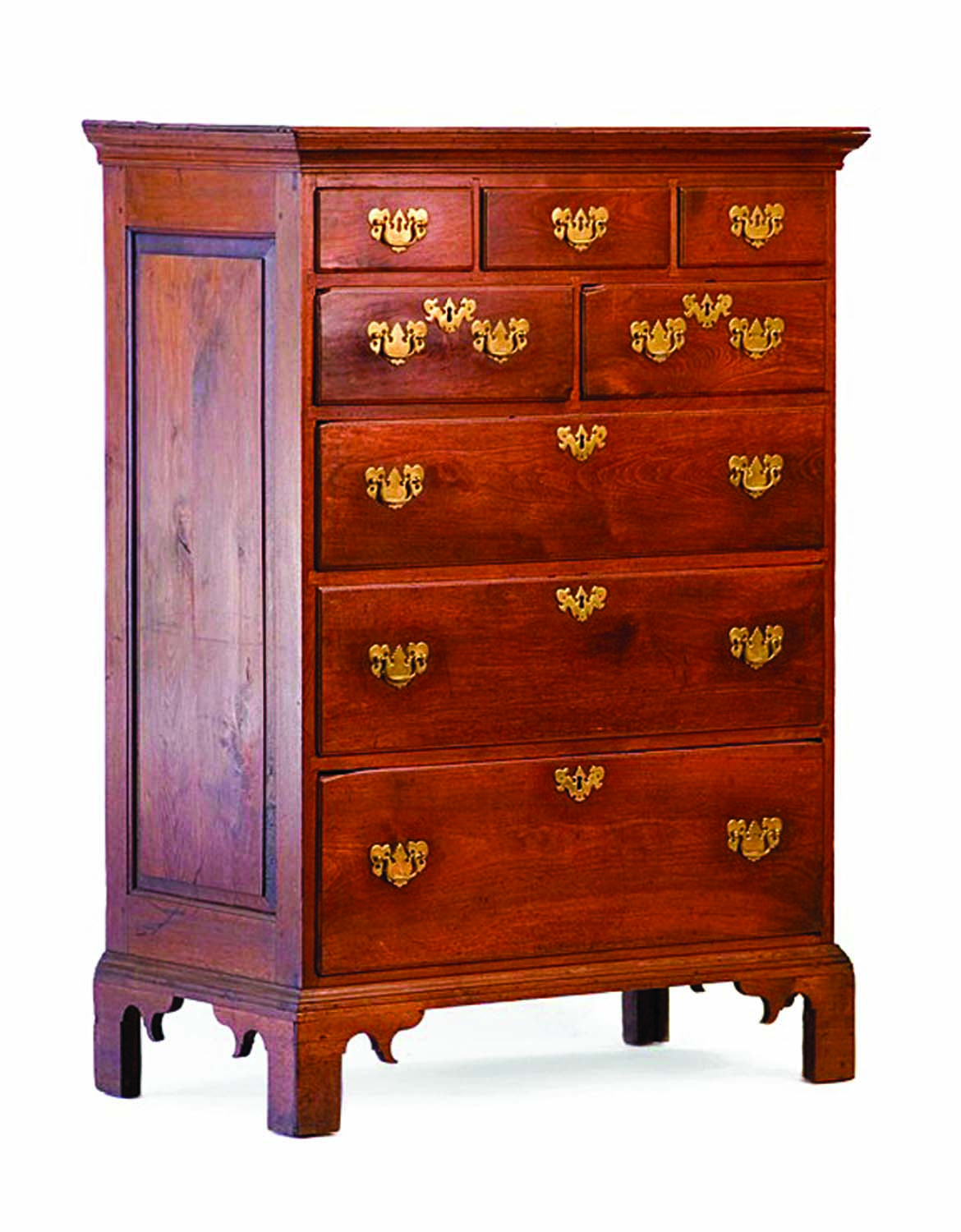
Simpler in the country. Located just outside Philadelphia, Chester County, Penn., had its own unique style of simple but elegant furniture, most often made of native walnut.
Another difference between Chester County furniture and the surrounding areas is a tremendous amount of line-and-berry inlay. While you can find string inlay on furniture from other areas, nowhere is it seen as often as on Chester County pieces.
Spice chests with line-and-berry inlay were extremely popular in the county, where this inlay also is found on blanket chests, Bible or document boxes, low and tall chests, and even on drop-leaf tables; most of it comes from the southeastern region of the county.
Round ‘Birdcages’
Many tilt-top stands and tables, made throughout the colonies, have a feature called a birdcage – a square wooden structure that allows the table to tilt as well as rotate. In the middle section of the county, in Downingtown, a number of tilt-top tables and stands were made with unique round birdcages.
Rural – but Sophisticated
Because it’s a rural area, people might expect the furniture of Chester County to be unsophisticated; they’d be wrong. Tall case clocks, an 18th-century status symbol, were made by many craftsmen living in the county. Chests-on-frames, a kind of highboy with fewer (if any) drawers in the base, as well as full-sized highboys, were made there by dedicated craftsmen for discriminating clients, not by farmers for their own use.
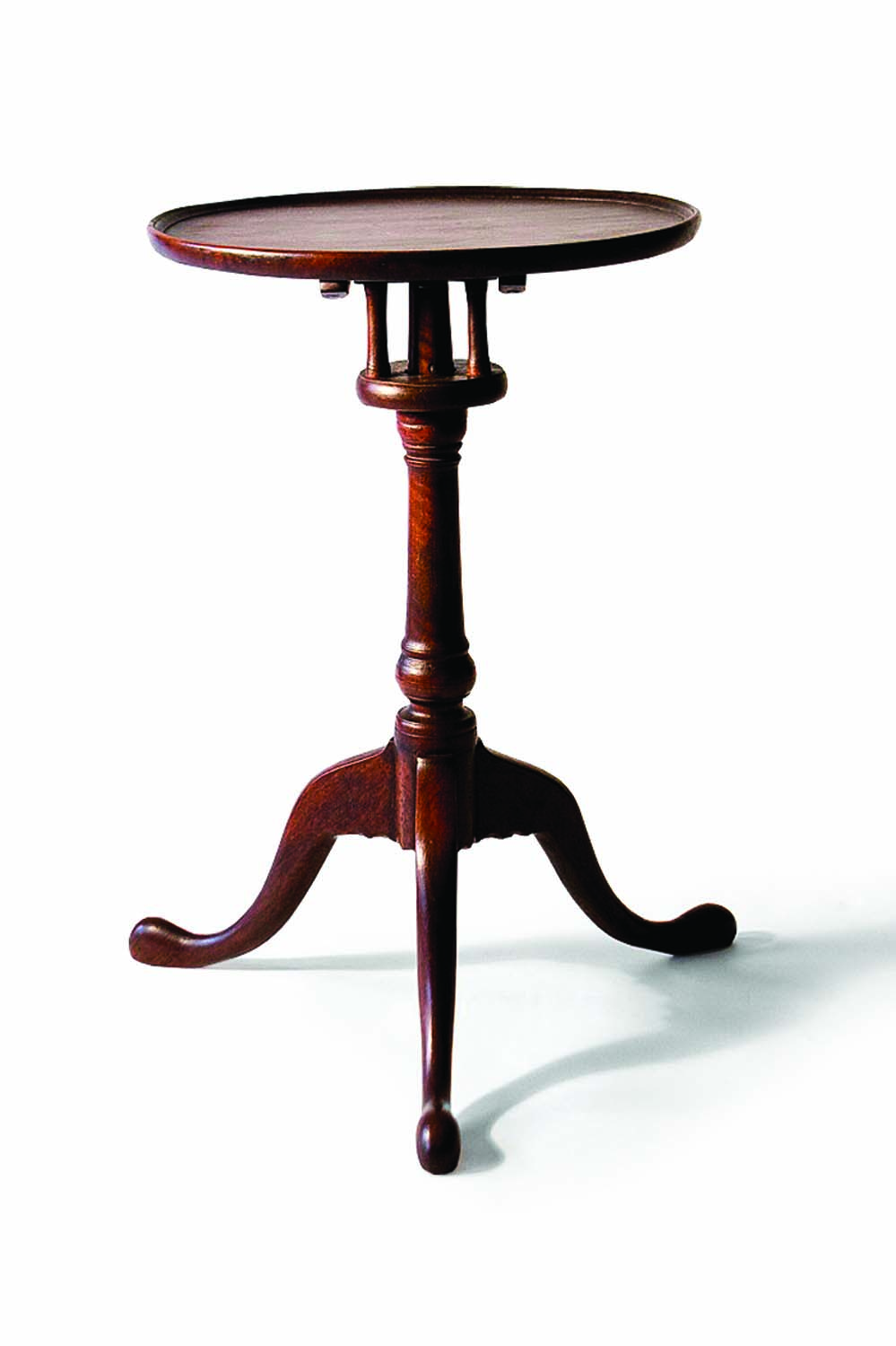
Birdcage. The mechanism that allows this candlestand to both tilt and rotate is called a “birdcage.” In the Downington area of Chester County, these are often round instead of the typical square shape. This design feature is specific to Downingtown, Penn.
In the early days of the county, wainscot chairs and ball-foot chests were popular. Early craftsmen also made William & Mary highboys for clients, which displays knowledge of this then-new furniture form. While the craftsmen of Chester County, and their patrons, were aware of the latest fashions, they tended to hold on to construction methods and design elements far longer. We see some chests, clearly from the Queen Anne or Chippendale periods, with elements held over from William & Mary, such as raised-panel case sides. 
When you consider how close Chester County is to Philadelphia, it is surprising how different the furniture is. Although it has the overall feel of Pennsylvania furniture, the people who settled in Chester County made furniture of their own by changing the designs to suit their own aesthetic, and began a furniture revolution within their communities. They could have followed the fashion trends of Philadelphia, but they resisted.
Inspired by these rural craftsmen, contemporary cabinetmakers working within the county today continue to create furniture made to a high standard. And while we contemporary cabinetmakers of Chester County build pieces from a variety of regions in a variety of styles, many have made the simple, elegant furniture of our home the mainstay of our bodies of work. Craftsmen from all over the country also take inspiration from those early residents, ensuring that the stylistic revolution that began centuries ago continues to this day.
Here are some supplies and tools we find essential in our everyday work around the shop. We may receive a commission from sales referred by our links; however, we have carefully selected these products for their usefulness and quality.








